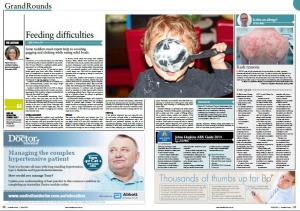
AUSTRALIAN DOCTOR CASE STUDY ARTICLE – Published in their magazine on 18th April 2014. Permission given to also have my article available on my website.
On referral
Lachlan, a 13-month- old infant was only eating smooth baby puree, a texture suitable for 6-month-olds. On advice from an occupational therapist, he was referred to my paediatric speech pathology practice for a feeding assessment.
Lachlan was born at term with no major health issues apart from mild reflux. Breastfed at birth, he transitioned to formula at 4 months of age. Solids were also introduced at 4 months. Lumpy foods were attempted at 8 months of age but discontinued due to ongoing gagging on lumps.
His mother described Lachlan as a “smallish toddler”: Developmentally, Lachlan was using 1 single word and cruising along furniture.
Lachlan’s mother had been to two GPs to discuss her feeding concerns and his “smallish” frame. Lachlan was tracking along the 10th centile for weight and between the 25th and 50th centile for length. His mother reported that both GPs were not concerned about medical or growth issues.
One GP had recommended introducing “fats”, such as meats, dairy, pasta, into his diet while the other had suggested reducing the number of bottles of formula (currently at 3 per day) to encourage Lachlan to eat more. Although both strategies did help to achieve weight gain, they did not address the problems of gagging and choking with textured food.
Feeding assessment
On feeding assessment, Lachlan’s oral movements with textured food appeared to be delayed for his age. For example, when given spoonfuls of puree, his tongue moved in a forward-backward motion without any lateralisation (sideways movement) of his tongue. Lachlan used this motion with both pureed (a savoury lunch meal) and lumpy food (mashed banana).
When offered more textured food pieces on the sides of his mouth, Lachlan demonstrated one up-down chewing jaw action but then quickly spat the food out.
Normal drinking skills, demonstrating a safe, coordinated swallow, were observed with a water “sippy” cup. There were no clinical signs of aspiration such as coughing or change in vocal quality with fluids.
In most cases toddlers will transition to textured food without difficulty. Children who have medical issues such as prematurity, gastro oesophageal reflux or developmental delays often have difficulties with developing their feeding skills along the normal continuum. In Lachlan’s case, he appeared slower to transition to solids than his peers with no specific underlying medical reason. This is not uncommon and is a frequent referral reason to paediatric feeding speech pathologists.
Recommended feeding strategies were explained, demonstrated and then written down for Lachlan’s mother to practice with Lachlan. The strategies mainly focused on developing Lachlan’s oral chewing skills — that is, tongue lateralisation and up-down jaw movements. A first follow up appointment was made at 2 weeks.
At follow up
Fast track 6 weeks later, and Lachlan, now 14½-months-old, is eating a good range of textured meals and finger foods. He is also more interested in self-feeding. Lachlan’s weight is now tracking along the 25th centile with his length along the 50th centile.
Lachlan’s oral skills are now advanced enough for him to manage softer finger foods such as crackers with spreads, cheese sticks and soft fruit, like bananas and ripe pears. Developmentally, he is now walking and using more single words. Lachlan’s mother is also a lot more confident at mealtimes and now looks forward to eating with her son.
If general treatment did not improve overall oral –motor chewing skills, then a multidisciplinary team approach involving consultations with a Paediatrician, Paediatric Dietitian as well as an Occupational therapist would have been sought to determine if there were underlying issues that had not been addressed such as reflux, allergies, muscle tone or sensory issues. Generally, most toddlers with difficulties transitioning to textured food will improve with Speech Pathology input focusing on developing their oral –motor skills.
Paediatric feeding is a specialist area within Speech Pathology. Paediatric Feeding Speech Pathologists are able to assess and treat a range of feeding difficulties in babies, infants, toddlers and children, from the more common cases such as Lachlan’s case to more complex cases such as tube weaning and oral feeding aversion commonly seen in children with specific medical diagnoses such as Pierre Robin Sequence and Down Syndrome as well as children with developmental delays including Autism Spectrum Disorder. Paediatric Feeding Speech Pathologists can generally be found working in paediatric hospitals as well as in specialist private practices across Australia.
Resources
1. Morris, SE. Feeding and Speech Relationships. New Visions 1998; See: www.new-vis.com/fym/papers/p-feed8.htm
2. Selley WG, et al. Coordination of sucking, swallowing and breathing in the newborn: its relationship to infant feeding and normal development. The British journal of disorders of communication 1990; 25:311-27.

